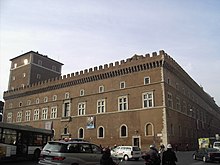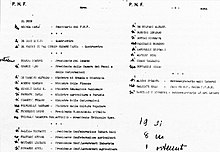Great Fascist Council

The Grand Fascist Council ( Italian Gran Consiglio del Fascismo ) was the foundation of Benito Mussolini's fascist government in Italy . Mussolini had been Prime Minister since October 30, 1922. The council was formed on December 27, 1922. The body not provided for in the constitution of the Kingdom of Italy ( Statuto Albertino ) was recognized as a state body by the constitution-breaking law of December 9, 1928. The council exercised great power over all the institutions of the Italian state.
construction
The following members belonged to the council:
Leader and head of government
- Benito Mussolini (until July 25, 1943 ),
The Quadrumviri
The four leaders of the 1922 March on Rome :
Representatives of state and party bodies
- The presidents of
- senate
- Chamber of Deputies , Camera dei Fasci e delle Corporazioni between 1939 and 1943
- The ministers of the following areas:
- The chairmen of the following institutions and associations:
- Accademia Nazionale dei Lincei ( forcibly merged with the Accademia d'Italia between 1939 and 1943 )
- Special Court for State Security ( Tribunale Speciale per la Sicurezza dello Stato )
- Corporation of Industrialists
- Agricultural workers
- Industrial workers
- Farmers
- The commander of the Milizia Volontaria per la Sicurezza Nazionale
- The General Secretary of the National Fascist Party (also General Secretary of the Grand Council)
Individuals
- Various individuals personally selected by Mussolini
tasks
In essence, the Grand Fascist Council had the following tasks and powers:
Inside the National Fascist Party
- Election of the fascist party deputies
- Election of the general secretary of the party and other party offices
- Approval of the party statutes
- Policy competence in party politics
Outside the National Fascist Party

- Hearing on the election of the heir to the throne
- Election of prime minister
- Selection of the members of the Chamber proposed by the professional associations (see literature below)
- Decision on the function and composition of the Grand Council
- Decision on the Prime Minister's powers, international treaties and foreign policy matters
In a meeting in May 1936, for example, the Italian “Impero” was proclaimed.
The Grand Council was convened by the Prime Minister. All ordinances and laws could only come into force with his consent.
The Great Fascist Council nevertheless succeeded in the bloodless disempowerment of Mussolini by taking Mussolini by surprise with a resolution demanding his replacement. This was followed by Mussolini's dismissal by the king.
Decision mode

Usually the resolutions were passed unanimously in favor of the items put forward by Mussolini in the respective agenda.
There were only two exceptions: At the meeting of February 13, 1923, it was decided that membership of the Freemasons was incompatible with party membership in the National Fascist Party ( Partito Nationale Fascista , PNF). Some members of the council voted against the proposal because they were Freemasons (Balbo, Acerbo , Rossi, Dudan), others voted in favor of the incompatibility , although or precisely because they were also Freemasons .
Mussolini's removal
A result that was devastating for Mussolini was the last meeting of the Grand Fascist Council, beginning on the afternoon of July 24, 1943. After a long discussion, it was decided in the early morning hours of July 25, 1943 by nineteen against eight at the request of Dino Grandi , with one abstention, the removal of the Duce and the return of power to King Vittorio Emanuele III. who wanted to replace Mussolini with Pietro Badoglio and to make peace with the Allies. Among the nineteen votes in favor of Mussolini's dismissal were those of his son-in-law, former Foreign Minister Galeazzo Ciano , and that of the very old " Marshal of Italy " Emilio De Bono .
After the deposition, Mussolini was imprisoned on the Gran Sasso in Abruzzo at the instigation of the Italian king , but despite secrecy, liberated by the Germans on September 12, 1943, so that he was able to reinstall a fascist state in northern Italy, the Republic of Salò . Five of the "nineteen renegades" were sentenced to death in the three-day show trial in Verona, which began on January 8, 1944 , and were executed on January 11, 1944 .
literature
- Rudolf Lill et al. a. (Ed.): Short Italian History. Bonn 2006.